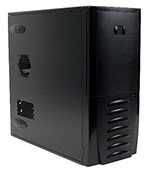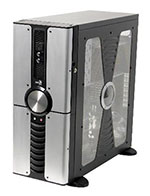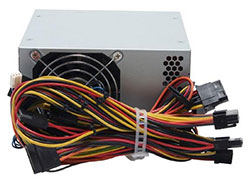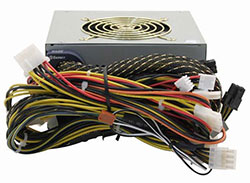Buyer's Guide: Mid-Range to High-End, May 2005
by Jarred Walton on May 23, 2005 5:30 PM EST- Posted in
- Guides
Case and Power Recommendations
Once you have all the internal parts picked out, it's time to find a home for your computer. This is often one of the most difficult decisions to make, as the case is what you'll actually see on a regular basis. If you're not worried about what the case looks like, you can probably get just about any cheap case at your local store. If you want something larger, smaller, flashier, quieter, etc., there is a case to fit your needs. Prices start at about $30 for the cheapest models (forget about the included power supplies!) and go all the way up to hundreds of dollars. We'll give a basic recommendation and a flashier alternative, but if you're looking for a truly exotic case, you're on your own. Well, maybe not quite on your own, but you get the idea.The power supply is a component that often gets overlooked, and for a modern system, we recommend spending a decent amount of money on a high quality power supply. The days of using the included "free" PSU are over for all but the lowest end computers. Sure, that 500W PSU might work well for a few weeks or months, but if you start experiencing system crashes and random instability, a low grade PSU - often with exaggerated performance characteristics - is a prime culprit. Generally speaking, you get what you pay for, so if a recognized name like Antec or Enermax is selling a 375W PSU for $40 and another manufacturer is claiming 500+ Watts for the same price, you should probably be suspicious at best.
Mid-Range Case Recommendation
Case: Antec SLK3000-B
Price: $56 Shipped
For good build quality at a relatively low price, Antec is always a safe bet. We're actually going to pull something of a cop-out and stick with an Antec SLK3000-B as our recommendation. It's nothing special in terms of looks, but it's reasonably quiet, affordable, and well designed. One 120mm fan is provided at the rear of the case with room for a second up front, and rails aid in the installation of hard drives and optical drives. About the only thing that you might find missing is front Firewire and audio ports, but that's not a major concern for most people. The SLK3700-BQE is a slightly more expensive model that does away with the CPU duct and the ventilation holes on the side panel while adding a 350W PSU. While we feel that most Mid-Range and higher PCs should have a better PSU, 350W ought to suffice for many people.
High-End Case Alternative
Case: AeroCool Spiral Galaxies
Price: $108 Shipped
This is definitely not a case for everyone, but we think that some people will really like it, so we're listing it as an option. It's a very large (full tower) case, so if that's not your style, look elsewhere. It does have some innovative features, like a wind tunnel to help keep the CPU cool. The wind tunnel has 120mm fans at the front and rear of the case, ensuring plenty of airflow; it's unfortunate that it doesn't provide air circulation for the GPU area as well, as SLI setups in particular could use some additional ventilation. The motherboard tray is reversed from the standard ATX design - it's on the left panel of the case - but while that's sort of like BTX, the design is still fully ATX compatible. The right panel has a case window with a honeycomb pattern on it (supposedly to reduce EMI), and the case has a door hiding the drive bays that can be locked if necessary. Another plus is the tool-less features for the fans and the expansion slots, and there are even rubber shock absorbers to help reduce noise from vibrations. Besides difference of opinion as to what looks cool, the only real problem is that getting the power cables from your PSU to reach all of the necessary areas can be difficult. If you go with a higher-end PSU, that usually isn't a problem, but you may not be able to determine whether or not a PSU will work until after you've purchased the parts. Overall, it's an interesting and innovative case design at a good price.
Mid-Range Power Supply
PSU: Antec SmartPower 2.0 400W
Price: $66 Shipped
While it is by no means the best power supply that you can find, Antec makes good quality units and provides a standard 3-year warranty for all their products. There are a few cheaper no-name brands that meet the new ATX 2.0 specification, but going with our above statement of prices being a decent indication of quality, we won't recommend a $45 500W ATX 2.0 PSU, as it simply sounds too good to be true. The 400W Antec model meets all the requirements of ATX 2.0, and the price matches up with the features. It has a 24-pin power connection for the motherboard as well as a 4-pin ATX12V adapter, one 6-pin PCIe power connection, two SATA power connections, four 4-pin molex adapters and a 4-pin floppy adapter. It also has dual 80mm fans to keep the internals cool, although that does cause it to create more noise than some other models.
The biggest complaint we have is that all of the cables are bare, meaning that there is no sheathing to make things look tidier. It doesn't really affect performance in any way, but if you have a case window, you might want something more attractive like an OCZ ModStream 450W. That runs about $25 more than the Antec and doesn't include dual 12V rails, but it does have a 24-pin power connector and you only need to plug in the cables that you're using. (The X-Connect Ultra, Antec NeoPower, AeroCool Turbine Power and probably several other PSUs have a similar design.) Fotron Source also makes a 500W PSU with sheathed cables that meets the ATX 2.0 spec, but it doesn't feature detachable cables. It might be a bit cheaper for comparable performance, but it still costs $90.
High-End Power Supply
PSU: Enermax EG565P-VE FMA2.0 SLI 535W
Price: $97 Shipped
For a high-end SLI system, you'll want to make sure that you have a very high quality power supply. The SmartPower 2.0 that we recommended above might be able to run such a setup as long as you didn't want more than one or two hard drives, but you're certainly pushing the limits of the PSU. A high powered graphics card like the 6800GT can easily draw 75W, so two of them running in SLI could use over 150W when gaming. Throw another 100W to the processor, and you've already used a sizeable chunk of the available power. We may have to look into the reliability of various PSUs in a future article, but for now, we would rather err on the side of caution, so we're going to go with power supplies in the 500W and higher range (or at least close to that). There are plenty of power supplies that still meet that requirement, including the 500W Antec SmartPower. However, since we're planning to use this in an SLI setup, what better way to guarantee proper support than to get an SLI certified PSU?
The Enermax Whisper II 2.0 (do you multiply to get 4.0?) has the relatively unique feature of including two 6-pin PCIe power connections. You also get the 24-pin and 12VATX connections for the motherboard, seven 4-pin molex plugs, two 4-pin floppy connections, and four SATA power adapters. The 535W of total power output should be more than sufficient for all but the most extreme configurations. The only real drawbacks are similar to that of the SmartPower. With the exception of the 24-pin cable, the cables aren't sheathed, so they look rather messy. You could sheath them yourself, but that's rather inconvenient.
If you're looking for other alternatives, there are quite a few PSUs that should work fine even with a high-end SLI configuration. Antec has their TruePower 2.0 units, Fotron Source and Seasonic are usually a good bet, and if you liked the alternative case recommendation, there's even a 550W AeroCool PSU that should work well. OCZ offers their ModStream, PowerWhisper and PowerStream units and they should all suffice, though the 600W PowerStream weighs in at a hefty $200+ price. Finally, Silverstone and CoolerMaster also have ATX 2.0 compliant power supplies that compare in price with the others in this list. You could probably get by with a power supply in the 400 to 450W range if you don't add too much other stuff to your system, but when you're talking about spending $700 or more just on graphics cards, we think that it's rather silly to try to save $10 or $20 on the power supply. It's a mistake that can come back to haunt you. It's better to have 150W more power than you need than to come up 25W short.














60 Comments
View All Comments
ProviaFan - Monday, May 23, 2005 - link
And I had an Epox board (8RDA, which was all the rage when it came out) die just over a year old from bad capacitors. Now, I use an Abit NF7-S v2, but found the guide useful as I'm planning an upgrade "soon" (dual core is necessary as I'm a non-gaming multitasker: Photoshop, Illustrator, Indesign - at the same time, and SMP is well beyond the budget).Thanks Jarred, I appreciated the article, despite the few typos and the whiner(s) in the comment section. :)
arswihart - Monday, May 23, 2005 - link
I think Epox is more than a step above Biostar and Soltek, as for customer support, Epox is lightyears better than Asus and MSI, so not sure what you are referring to there. They also have the best BIOS support I've ever seen, always updated quickly and often, so again I don't know where you are getting your information.kevindarcy - Monday, May 23, 2005 - link
For those of us who run our PCs continuously, I think Anandtech should be giving a clear recommendation of Venice over Newcastle, regardless of their respective overclocking potentials, or support of SSE3. According to PC Perspective (http://www.pcper.com/article.php?aid=127&type=... a Venice CPU consumes 20W less than an equivalent Newcastle at idle, and 37W less under load (!). Where I live, the electricity savings alone, based on the "idle" number, are at least $16/yr, more than enough to justify the (hopefully temporary) price differential, not to mention the "intangible" benefits of having a quieter, cooler-running computer.JarredWalton - Monday, May 23, 2005 - link
15 - typo. Fixed now.1 - Would you buy a LAN card for a PC? Most people would say no, and I feel about the same for audio. If you find the integrated audio is lacking, it's simple enough to add a sound card after the fact.
whatever - Monday, May 23, 2005 - link
quote:That means Intel's 845 and 855 chipsets or the aforementioned nForce 4 SLI for 775.
Isn't 845 and 855 old? don't they mean 945 and 955? (this is from the Intel mobos section)
KristopherKubicki - Monday, May 23, 2005 - link
>and I even wonder sometimes if your site is getting some compensation for these recommendations.arswihart: Generally we will always recommend at Tier 1 motherboard manufacturer over a Tier 2 one. The peripheral things like product support, updates and MTBF usually sway our opinion in favor of an ASUS/MSI/Gigabyte board over a Biostar/Epox/Soltek board even if they are nearly the same. By the way, Epox's production was actually via another Tier 1 production house until not too long ago.
Kristopher
JarredWalton - Monday, May 23, 2005 - link
*I'm* not in the market for an SLI rig. Very few people really are. My 6800GT is more than powerful enough for what I do, and I think most people feel the same way.The reason I went with SLI for the High-End is because I feel people that are interested in spending $500+ on a CPU are probably going to be interested in the bragging rights of SLI. I think the Mid-Range is the sweet spot for computer purchases, so I really look at the High-End market as potential upgrades rather than entire systems. Of course, if you win the lottery or something, go for it! :)
arswihart - Monday, May 23, 2005 - link
i only say that because the products I refer to have been available for many many months, except for the 9npa sli. It is nonsense that you haven't been aware of their existence until today.arswihart - Monday, May 23, 2005 - link
you mean you miss all of them, not just some of themJarredWalton - Monday, May 23, 2005 - link
I've been going by the AnandTech Pricing Engine (which is apparently missing the EPoX and Biostar SLI products). I generally search around at Newegg, ZipZoomFly, ChiefValue, Monarch, and several other sites to verify that I've got the best prices I can find as well as most recent product lists, but obviously I miss some of them. Sorry.As for the EPoX nF4 Ultra vs. Chaintech, I wouldn't say the EPoX board is bad (though I haven't tested it), but past experience is that it's probably not much better than other options. We'll be coming out with a new nF4 motherboard roundup, so I'll have to see what our other editors say about the various models. :)
(I did mention nF3, by the way - at the top of the page. I would't recommend it for a complete new system, but for upgraders it's still a reasonable choice.)